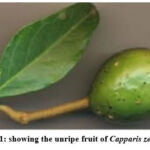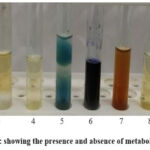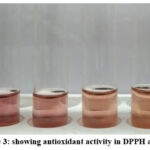Suchitra M R1 and Parthasarathy S2*
and Parthasarathy S2*
1Department of Chemistry and Biosciences, SASTRA, (SRC) (deemed to be university) Thanjavur, Kumbakonam, India.
2Department of Anaesthesiology, Mahatma Gandhi Medical college and research institute, Sri Balaji Vidyapeeth, (deemed to be university) Pondicherry, India.
Corresponding Author E-mail: painfreepartha@gmail.com
DOI : https://dx.doi.org/10.13005/bpj/2849
Abstract
Capparis zeylanica (Aadhandangai) is a 2- to 5-meter-tall shrub endemic to India and other Asian nations. The leaves are anti-inflammatory, anti-oxidant, and anti-helminthic. Several studies have been carried out to illustrate the medicinal and therapeutic properties of leaf extract. A careful examination of the literature identified no studies on unripe fruits, which are customarily eaten on the festival of Aadi Amavasya (new moon day of July-August). Capparis zeylanica, used for the study was recognised by a team of botanical experts and a marketing expert with an expertise of more than four decades. Unripe fruits were assessed for mineral content and antioxidant DPPH test. The phytochemical analyses were carried out using the procedures outlined. The Roche/Hitachi Cobas 6000 analyser series was used to measure trace elements and minerals such as phosphorus. The fruit showed the presence of antioxidants. The phytochemical studies also revealed proteins, amino acids, and saponins. The fruit was high in calcium and phosphorus (> 48.0 mg/100 gm), but low in zinc and magnesium. It also had vitamin D and B12. The presence of trace minerals and vitamins with anti-oxidant action makes it a food; however, an excess of calcium with phosphorous may cause injury to a weak kidney, therefore an annual and infrequent consumption may have been advised. So far, there is no literature on the plant's immature fruit. This study is the first to demonstrate the utility of the customary practice of annual intake.
Keywords
Aadhandangai; Aadi month; Antioxidant; Capparis zeylanica; Fruit; minerals
Download this article as:| Copy the following to cite this article: Suchitra M. R, Parthasarathy S. Evaluation of Antioxidant Effects and Estimation of Trace Minerals in Unripe Fruits of Capparis Zeylanica (Aadhandangai) – An Invitro Study. Biomed Pharmacol J 2024;17(1). |
| Copy the following to cite this URL: Suchitra M. R, Parthasarathy S. Evaluation of Antioxidant Effects and Estimation of Trace Minerals in Unripe Fruits of Capparis Zeylanica (Aadhandangai) – An Invitro Study. Biomed Pharmacol J 2024;17(1). Available from: https://bit.ly/487Jnsm |
Introduction
Plants as herbs are frequently studied for medical purposes. A variety of herbs have been investigated for their antioxidant and anti-cancer properties1-3. The evergreen climbing shrub Capparis zeylanica (Aadhandangai) is native to India, the Andaman Islands, and a few South Asian countries. In the countryside and bushes, the plant is harvested for local use as a drug and, on rare occasions, as food. There have been a few studies on its medicinal use, but there is little literature on its unripe fruit consumption4. Rayars and Vaishnavites, a rare community in South India, used to take this unripe fruit once a year on the new moon day of the Aadi month, which corresponds to July-August in the English calendar. According to rituals, the fruit is only supposed to be eaten once a year. We attempted to analyse the unripe fruit in terms of antioxidants and trace elements in order to understand the importance of avoiding frequent consumption. The study tried to investigate the antioxidant effects of the plant’s unripe fruit as well as the presence of trace elements in the crushed fruit of Capparis zeylanica. Since these fruits are seasonal, the analyses could only be performed in the months of July and August
Methods
The plant ofCapparis zeylanica was identifiedby the team of botany experts and a marketing expert of this fruit for more than four decades. (Fig 1)
 |
Figure 1: showing the unripe fruit of Capparis zeylanica |
The Phytochemical analyses was done according to described methods5.The DPPH radical scavenging capacity of rhizome extracts was measured using the classically described methods. Twelve mg of DPPH was dissolved in 50 ml of methanol to make a stock solution. Diluting the stock solution to achieve an absorbance of 1.05 yielded the working solution. 2. 8 ml of the working solution (1 mg/ml) was added to 200 ml of the diluted plant sample. The reaction mixture was thoroughly mixed and incubated in the dark for 15 minutes. The absorbance was then measured at 517 nm with BHT as the standard6. The elements were analysed after feeding into an automated instrument which analyses the elements. Trace elements and minerals including phosphorus were measured using The Roche/Hitachi Cobas 6000 analyser series. Each mineral is analysed a validated technique whose description is beyond the scope of this article.
Results
The phytochemical content is tabled below (fig 2 and Table 1)
 |
Figure 2: showing the presence and absence of metabolites. |
Table 1: showing the presence or absence of metabolites
|
S.No. |
Phytochemical |
Result |
|
1 |
Alkaloid |
Presence |
|
2 |
Carbohydrate |
Absence |
|
3 |
Glycosides |
Absence |
|
4 |
Saponins |
Presence |
|
5 |
Protein |
Presence |
|
6 |
Amino Acids |
Presence |
|
7 |
Phenolic |
Absence |
|
8 |
Flavonoids |
Absence |
|
9 |
Terpenoids |
Absence |
|
10 |
Steroids |
Absence |
The antioxidant properties are clearly shown in fig 3 and table 2
 |
Figure 3: showing antioxidant activity in DPPH assay |
Table 2: showing antioxidant properties
|
Concentration (µg/mL) |
Absorbance |
Average |
Inhibition (%) |
|
|
I |
II |
|||
|
Control |
0.943 |
0.94 |
0.9415 |
0 |
|
20 |
0.749 |
0.743 |
0.746 |
20.76 |
|
40 |
0.567 |
0.573 |
0.57 |
39.45 |
|
60 |
0.532 |
0.531 |
0.5315 |
43.54 |
|
80 |
0.517 |
0.519 |
0.518 |
44.98 |
|
100 |
0.486 |
0.482 |
0.484 |
48.59 |
The mineral contents with normal values are tabled below (Table 3)
Table 3: showing mineral content of aadhandangai compared with plasma values and commonly taken fruit banana.
|
Mineral |
Observed value Aadhandangai |
Plasma value normal |
Banana |
|
zinc |
270 ug/100 gm |
70 – 120 ug/dL |
150 ug/100 gm |
|
Magnesium |
4.12 mg/100 gm |
1.8 – 2.4 mg/dL |
27 mg/100gm |
|
Calcium |
> 48.0 mg/100 gm |
8.8-10.0 |
Minimal |
|
Phosphorus |
37 mg/100 gm |
2.3-4.7 |
22 mg/100 g |
|
Vitamin B12 |
1.6 mg/100 grams |
187-833 pg/ml |
0 |
The trace elements like mercury and arsenic are well below the estimating limits. Iron was present in traces. Cyanocobalamin and vitamin D are also present in this unripe fruit
Discussion
Capparis zeylanica (Aadhandangai) is a 2-to-5-meter plant growing in the shrubs of India, and other parts of Asia. The leaves have got anti-oxidant, anti-inflammatory and anti-helminthic properties. There are a lot of studies to prove the medicinal and beneficial effects of leaf extract7,.8 A thorough literature search has not revealed any studies on unripe fruits which has been traditionally consumed on the day of Aadi Amavasya. The unripe fruit contains proteins, aminoacids, and proteins without carbohydrates, which contribute to its medicinal properties rather than its use as a food. Typically, the plant’s fruits do not ripen. As a result, unripe fruits are consumed. The authors have noted that unripe fruits decay after a few days of plucking.. There are alkaloids and saponins which confer anti-oxidant effect but the presence of saponins alone can be toxic to human health. This may be part of the reason to avoid frequent intake of the fruit. A significant finding there is an absence of flavonoids, phenols and terpenoids. This finding goes against the previous studies which established such chemicals in leaf extract.8 Considering the vitamins and minerals, it contains B 12 which is usually an animal source. Hence possibly to support vegetarians in terms of this vitamin, the fruit may be advised once in a year. When compared to banana, a commonly taken fruit, it has got excess of phosphorous, calcium. This combination in excess may not be good for health increasing the propensity for atherosclerosis and vascular diseases9,10. The possibility of excess calcium and phosphorus a leading on to kidney damage is reported. Hence minimal vitamin D along with excessive phosphorous and calcium is likely to cause renal damage if given daily. Hence, this fruit is possibly advised to be taken once in a year. We have our limitations. The exact reason for the occasional intake is unclear. We have suggestions. Further detailed analyses of toxic elements may throw light in this angle. This fruit being a seasonal one in July -August, we cannot analyse the fruits budding in other seasons. In terms of vitamins and minerals, it contains B 12, which is usually obtained from animals. As a result, the fruit may be recommended once a year to vegetarians in terms of this vitamin. It has long been assumed that there are no known sources of Vitamin B 12 in plant foods. However, it has been established that cow dung used as manure can increase vitamin levels in plants. Because cow dung is widely used and available, this could be one of the proposed mechanisms for the presence of vitamin B 12 in this fruit. Fruits like oranges and vegetarian foods like spinach contain vitamin D. This unripe fruit in our study may have a low vitamin D content. This fruit has not been studied previously, and we conducted the first-time analyses to detect it. This fruit appears to be unique in demonstrating antioxidant activity from the proteins themselves. There have been a few studies that show the same thing occurs in different plants.13,14 We have not studied the anti-helminthic and anti-cancer potential of the fruit. This study may give a clue to why this is being advised for an annual intake. There is no evidence for the timing of intake. This fruit being seasonal is most abundant in the month of Aadi. (July- August)
Conclusion
We conclude that unripe Capparis zeylanica (Aadhandangai) fruits have antioxidant properties. The presence of saponins may contribute to the fruit’s possible toxic potential. The abundance of calcium and phosphorous in this fruit may favour a pulsed dose rather than a regular intake. There was also zinc, magnesium, vitamins D and B12. We theorize that the fruit being a vegetarian source of B12 could be due to cow dung manure or soil changes. We accept that our study has not clarified the reasons behind annual intake with authority. We are trying to get the unripe fruit in other seasons to establish differences if any.
Acknowledgement
Our sincere thanks to Harman research centre,Thanjavur India for their help in analyses.
Conflict of Interest
There is no conflict of interest.
Funding Sources
There are no funding sources
Author Contributions
MRS – concept and methodology
SPS – manuscript writing and communication
References
- Mohesh G, Pradeep P, Rashmi KS, Meerasa SS, Govindasamy V. Effect of methanolic extract of Dendrophthoe falcata leaves on acute hyperglycemic adult zebrafish. Natl J Physiol Pharm Pharmacol 2022;12(10):1692-1697.
CrossRef - Kadalmani B, Niranjana R, Natarajan UA, Chandiran IS. Antifertility and Antioxidant Activities of Ethanolic Extract of Leonotis nepetifolia in Male Albino Rats. J Basic Clin Appl Health 2020;3(3):115–121.
CrossRef - Shivashankar Kengadaran, Srisakthi. D., Divvi Anusha, Gopinath Prakasam, Kavitha. M, Vigneshwari. S.K. Comparing the efficacy of Neem extract, Aloe vera juice, and 0.2% Chlorhexidine against dental unit waterline pathogens. an In-vitro study. Research Journal of Pharmacy and Technology. 2021; 14(4):2224-8.
CrossRef - Warake, R.A., Jarag, R.J., Dhavale, R.P. et al. Evaluation of in vitro antioxidant, anticancer activities and molecular docking studies of Capparis zeylanica Linn. leaves. Futur J Pharm Sci.2021:(7), 76.
CrossRef - J. Padmavathy, T. Venkatachalam, I. Sarath Chandiran, S. G. Raman, R. Rajkumar, D. Saravanan. Evaluation of Anti-inflammatory and Anti-diabetic activities of Actinodaphne madraspatana bedd leaves. Research J. Pharm. and Tech. 2021; 14(1):47-51.
CrossRef - Senguttuvan J, Paulsamy S, Karthika K. Phytochemical analysis and evaluation of leaf and root parts of the medicinal herb, Hypochaeris radicata L. for in vitro antioxidant activities. Asian Pac J Trop Biomed. 2014 May;4(Suppl 1):S359-67.
CrossRef - Sini KR, Sinha BN, Rajasekaran A. Protective Effects of Capparis zeylanica Linn. Leaf Extract on Gastric Lesions in Experimental Animals. Avicenna J Med Biotechnol. 2011 Jan;3(1):31-5.
CrossRef - Ghule BV, Murugananthan G, Nakhat PD, Yeole PG. Immunostimulant effects of Capparis zeylanica Linn. leaves. J Ethnopharmacol. 2006; 108:311–5.
CrossRef - Warake, R.A., Jarag, R.J., Dhavale, R.P. et al. Evaluation of in vitro antioxidant, anticancer activities and molecular docking studies of Capparis zeylanica Linn. leaves. Futur J Pharm Sci (2021) 7, 76.
CrossRef - Gunnar H. Heine, Masaomi Nangaku, Danilo Fliser, Calcium and phosphate impact cardiovascular risk, European Heart Journal, 2013;34, (15),1112–1121,
CrossRef - Watanabe F, Yabuta Y, Bito T, Teng F. Vitamin B₁₂-containing plant food sources for vegetarians. Nutrients. 2014 May 5;6(5):1861-73.
CrossRef - Mozafar A. Enrichment of some B-vitamins in plants with application of organic fertilizers. Plant Soil. 1994; 167:305–311.
CrossRef - Zuo M, Liu XX, Liu D, Zhao HY, Xuan LL, Jiang WX, Li WZ. Extraction, Characterization and Antioxidant Activity in vitro of Proteins from Semen Allii Fistulosi. Molecules. 2018 Dec 7;23(12):3235.
CrossRef - Ryan J. Elias, Sarah S. Kellerby & Eric A. Decker. Antioxidant Activity of Proteins and Peptides, Critical Reviews in Food Science and Nutrition, (2008) :48:5, 430-441.
CrossRef








